Kitchen flooring - advantages and disadvantages of various options
A kitchen is a special purpose room. And to its arrangement and functionality, increased requirements are manifested. To describe briefly what kind of kitchen should be, one word can be used - comfortable. It should immediately be noted that not the last role is given to the kitchen cover in the kitchen. Is there an ideal flooring for this room and how to choose it? These are the questions we will try to answer.
Key Coverage Requirements
Kitchen - classified as a high attendance room, in this regard, the flooring should first of all have the following characteristics:
- Moisture resistance.
- Strength.
- Visual appeal.
- Functionality
But this does not exhaust the list of requirements for covering the kitchen floor. Ideally, he should not be afraid of accidental scratches, greasy stains, and cleaning and washing should not cause special difficulties. Naturally, the kitchen floor is not a separate “organism” living on its own.
It must fully comply with the overall stylistic decision of the room. However, one cannot ignore the circumstance on which basis the coating will lay: perhaps the old one is quite suitable, or maybe you will have to do everything from scratch. It is the base that is the determining factor of such a parameter of the kitchen floor as durability.
Before buying material for flooring in the kitchen, you should consult a specialist regarding the base of the floor cake. Moreover, in a conversation, make the necessary emphasis on the fact that the floor will be heated, if there is such a plan. Indeed, proceeding from these conditions, only materials with good thermal conductivity and at the same time high resistance to temperature fluctuations will be considered. As for the design, there are also many options.
If square meters allow, and instead of concise and quiet flooring I want to do something spectacular and extraordinary, claiming to be the main element of the decor of the entire kitchen room, then maybe a combination of two materials will be considered. This is also done for practical reasons: usually the working area is covered with ceramic tiles or porcelain stoneware, and the dining area is made of natural wood, parquet or laminate.
Which flooring is best?
Now we will dwell on certain types of floor coverings in more detail:
Option # 1 - linoleum
Natural and artificial linoleum is a versatile material, including one that is excellent for the kitchen. Currently, manufacturers offer a huge selection of its patterns, colors and textures.
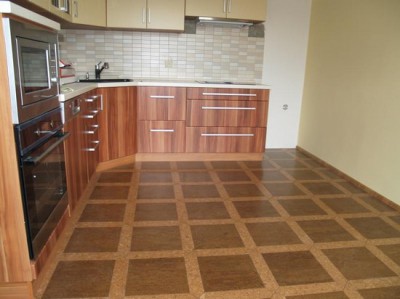
Advantages: reasonable cost and high wear resistance. Average life of 8-10 years. It has good heat and sound insulation. Unpretentious in leaving, and everyone will be able to put it on their own.
Disadvantages: the synthetic version is not environmentally friendly. Some types are suitable for use only in non-residential premises, for example, on a loggia - this will be indicated by marking. More environmentally friendly species: artoliums and mormoliums. However, their price range is much higher than that of the classic look. Linoleum is poorly resistant to mechanical damage, and also does not "like" exposure to direct sunlight.
When choosing, it is very important to pay attention to the smell: the stronger it is, the lower will be its environmental safety.
Option # 2 - Cork
This option of a kitchen floor will not cause complaints from fans of environmentally friendly materials. This coating is made from cork oak bark. It is removed once every few years directly from a growing tree.
Advantages: very beneficial effect on the well-being of people. Unconditional comfort for the legs - the load on the spine and joints is reduced, and in addition, the cork:
- It is a natural antistatic agent;
- does not actually attract dust;
- easy to clean:
- stain resistant;
- safety - it is impossible to slip;
- excellent sound insulator;
- creates the effect of "warm floor";
- when walking pleasantly springy.
It is believed that cork has unique bioenergy properties. The market offer is characterized by a variety of textures and shades.
Disadvantages: does not tolerate excessive humidity and is “afraid” of direct contact with water. If the material is adhesive, then the installation process requires thorough preparation and special skills. With a thickness of less than 3 mm, its soundproofing properties are sharply reduced. Some collections of cork coverings have an excessively rough surface, which greatly complicates the care of it.
To use cork in the kitchen, it must be coated with a special varnish. This will completely protect her when a small amount of liquid gets into it.
Option # 3 - natural wood
Natural wood floors in the kitchen look respectable and rich. They fit perfectly into any "picture", but are especially suitable for the interior of the kitchen in the style of "classic" or "country".
Advantages: aesthetic appeal and 100% environmental safety. Contribute to the creation of an ideal healthy indoor microclimate. Disadvantages: Does not like temperature changes and increased moisture. It is advisable to lay such floors in the dining area. They need constant processing and special protective compounds for wood. They require constant care. Sometimes it is difficult to remove stains from spilled wine, juice or plain water from a wooden coating - there are traces. And the biggest drawback is the high cost.
Option # 4 - Laminate
Laminate flooring, in principle, is a worthy alternative to natural wood. And thanks to modern technology, a laminate board perfectly imitates any kind of wood, granite, marble, tile and many others.
Advantages: perfectly withstands various mechanical influences. It is distinguished by the availability of installation and a relatively low price. Disadvantages: weak point - high humidity. Ecologically inferior to cork and wood.
Laminated kitchen flooring is best done from a laminate, characterized by increased water repellent ability.
Option # 5 - ceramic tiles
This coating actually reigns in rooms such as the kitchen. Manufacturers offer ceramic tiles of all colors of the rainbow and various textures - there are practically no restrictions.
Advantages: practicality, durability, strength, wear resistance. Gives tremendous scope for experimentation to interior designers. It can simulate any floor covering. Relatively inexpensive floor material. Disadvantages: the most significant is “cold.” You can’t walk barefoot on it. If there are children, then the installation of a "warm floor" system is recommended.
Ceramic tiles should be matte. This will help to avoid injuries.
Summary
This review of kitchen flooring can be continued for a very long time - more and more options are constantly appearing on the market.We talked about the most popular of them today, but the choice to make, of course, to you.

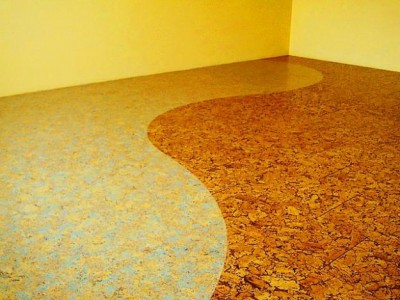
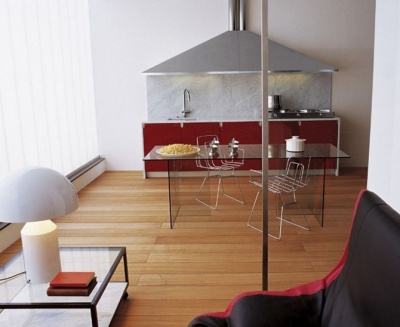

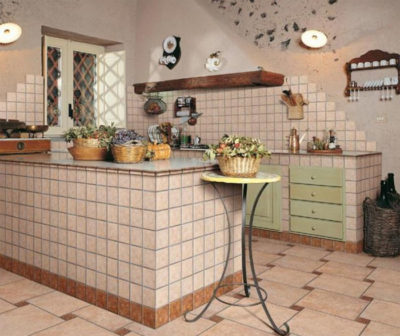
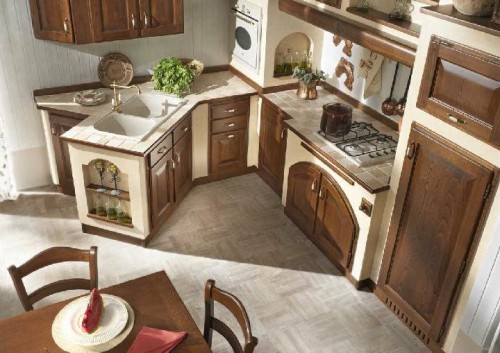
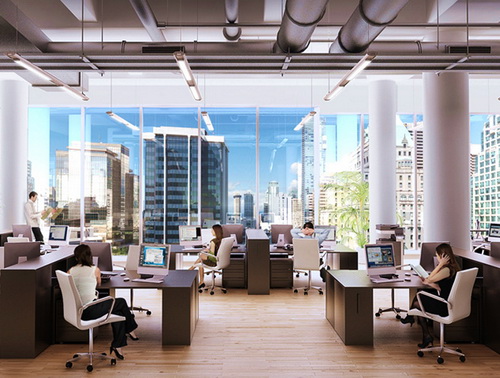

1 comment